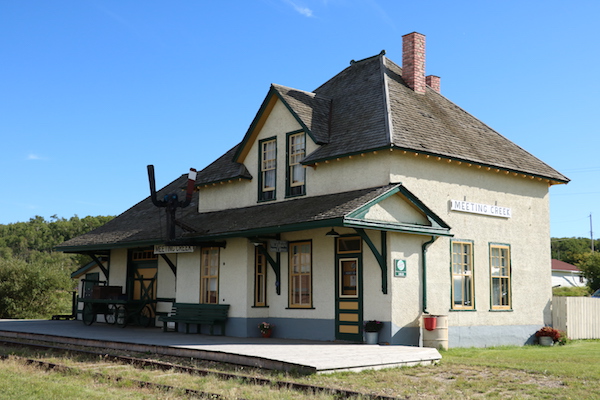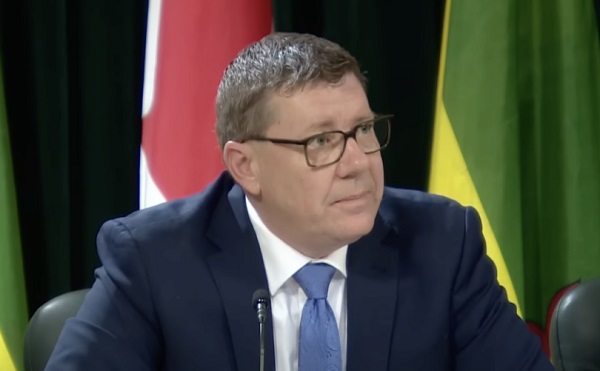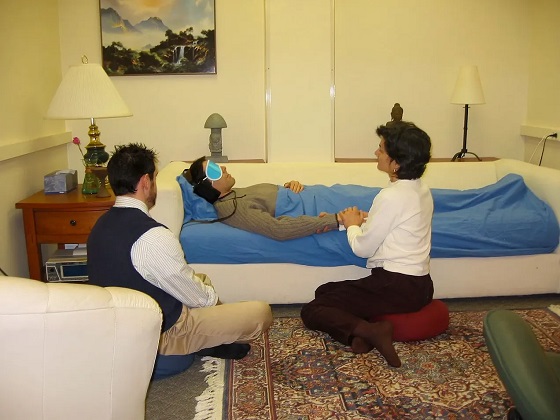Alberta
Summer Vacation Idea – Central Alberta’s collection of Train stations preserved along the Highway 56 Corridor

Article submitted by Paul O’Neil
For decades, the railroad station or “depot” was the transportation hub of many communities across North America. As the “storefront” for the railway company, the depot was the town’s gateway, handling express freight, serving travelers, and providing vital communication in an erathat is now almost forgotten. In Canada’s West, the remaining small-town depots that continue to exist are now museums, private businesses or residences, or in the worst cases have been left to deteriorate as hulks on private property.
There is however a special historical railway on the Prairies that has developed into a true “historic railway district”. A visit to the depots preserved by the Canadian Northern Society in Central Alberta provides a glimpse into the past – an entire collection of classic railroad station designs, carefully and lovingly maintained by a dedicated group of volunteers.

History Background:
Members of the Canadian Northern Society include historians, community volunteers, gardeners, and other local supporters who have since 1987 been active in the preservation of its namesake railway’s history, and in particular its depots. The Canadian Northern Railway (CNoR) traces its origins to Manitoba in 1896. Visionary founders Sir William Mackenzie and Sir Donald Mann – both instrumental as contractors in the completion of the Canadian Pacific Railway – grew the company from a modest short line between Gladstone and the Dauphin district of Manitoba into to a 9500 mile transcontinental system.
Despite the relative business success of the CNoR’s branchline network, negative financial impacts created by the First World War, together with mounting debt from the over-expansion led to the company being nationalized in late 1918. By 1924, operations in Central Alberta were amalgamated with the rival Grand Trunk Pacific Railway under the newly formed Canadian National Railways (CN) banner.
DEPOTS
Similar to other western railroads, the CNoR designed standard plans to be used at individual locations based on the size and importance of the locality to be served. In Alberta, the most common CNoR design was the combination freight and passenger “Third Class” station. Several “Second Class” depots intended primarily for divisional points were constructed, and a single-story “Fourth Class” depot design were also found. The designs were flexible enough that additions could be constructed as traffic or operations warranted. The distinctive pyramid or “semi-pyramid” roofline of a CNoR depot, a feature designed by company architect Ralph Benjamin Pratt, created a unique and pleasing image.
By the late 1960’s the depot-era on the former CNoR Battle River Subdivision (a large portion had by then been renamed the “Stettler Subdivision”) was drawing to a close. However, the presence of a branch line passenger service in the form of a Budd RDC service between Edmonton and Drumheller ensured the continued existence of several depots as passenger shelters that otherwise would most certainly face demolition. The Edmonton to Drumheller service lasted into VIA Rail Canada times until the Trudeau Government service cuts of November 1981 gutted passenger service across Canada.
ENTER THE CANADIAN NORTHERN SOCIETY
Meeting Creek, MP 21.2

My beautiful picture

By 1986, the CNoR Third Class depot at Meeting Creek was surviving on borrowed time, vandalized and yet escaping the fate of several identical structures in neighboring towns. As a result of an interest by a small group of younger railroaders and rail historians, powered perhaps by a few pints enjoyed in a Stettler pub, the Canadian Northern Society (CNoS) was soon established with the intent to save this classic structure from imminent destruction.
Armed with enthusiasm, some grant money, and the support of short-line Central Western Railway; the CNoS got to work repairing the roof, floors, rebuilding the wooden platform, painting, and replacing missing windows, doors and chimneys. By 1989 the Meeting Creek depot was resurrected from a sad state to her today’s 1940’s-era appearance.
Complimenting the station today is another vanishing prairie icon. A 1917 Alberta Pacific Grain elevator located across from the depot was purchased by CNoS from the Alberta Wheat Pool in 1992. Over the years, it too has been conserved by the Society and work continues into its second century. A second grain elevator, while privately owned, ensures that Meeting Creek continues to feature two classic prairie elevators that dominate the skyline in this picturesque location.
Donalda, MP 30.9:

9.7 miles south of Meeting Creek lies the Village of Donalda. Always an agrarian-based community, Donalda was never larger than 500 souls, and as such rated a Canadian Northern Railway “Third Class Depot”. Unfortunately, the original depot at Donalda was demolished in 1984.
Thanks to the efforts of the CNoS, the group was able to relocate an original CNoR “Fourth-Class” type depot, donated by a Saskatchewan farmer many miles to the east. All the Societyhad to do was physically move this building 700 miles from her location at Vandura, Saskatchewan to Donalda! Through fundraising and community support, the building was moved to Donalda in 1991. The depot was restored to her CN oxide red paint scheme, with cream trim on the windows and facia boards. The interior of the depot was refurbished to her heyday as a depot and is now included in the present-day collection of the Donalda & District Museum. Like Meeting Creek, a short section of original CNoR 60-pound steel main track remains preserved in front of the depot.
Warden MP 55.8:

Five miles south of Stettler is the one-time important junction of the CNoR Brazeau Subdivision, its westward extension into the coal fields at the foot of the Rockies. Originally, a “Fourth Class” station was located here, being destroyed by fire and replaced with a standard later version of the company’s “Third Class” design in 1919. This structure was sold and demolished in the 1980’s, and was recently replaced by a “representative” train order office/depot built entirely by CNoS volunteers, that features design features, artifacts, and “parts” of the original depot. It is used for educational purposes in a peaceful park-like setting along what is now short-line Alberta Prairie Railway.
Big Valley, MP 72.1:


Established in 1911, Big Valley was once hub of the division for the CNoR. By 1921 this one-time bustling terminal boasted well over 300 employees on payroll and featured a 10 stallroundhouse, coaling plant, water tank, and other terminal facilities. Big Valley’s 1912-built depot was a large “Second Class” design commonly constructed by the CNoR at divisionalpoints across the system. The main floor handled passenger and LCL business, while the second-floor housed accommodations for the agent – and later crews and offices.
The Big Valley depot was the second major conservation project for the Canadian Northern Society in 1989. Encouraged by the Village of Big Valley, CNoS began refurbishment of the station, and was able to raise funding from Alberta Historical Resources Foundation and various temporary job creation programs to restore the depot to today’s attractive 1940’s-era exterior appearance.
At the same time, short–line operator Central Western Railway was launching Alberta’s first tourist railroad service. Big Valley, like in her previous railroad life, again had the infrastructure to accommodate steam powered trains into the community. In addition, the 10-stall roundhouse,by then in ruins with only the concrete walls showing her prominence to the community was preserved as an interpretive park through the efforts of CNoS, Central Western, and the Village of Big Valley. Volunteers cleared and excavated the site, allowing the view of the ash and turntable pits, boiler room and machine shop. You can imagine the one-time bustling activity of Ten-Wheelers and Consolidations locomotives receiving service at the Roundhouse.
Big Valley today is the centerpiece of this rich CNoR heritage, plus a restored grain elevator to complete the scene of a bustling prairie railroad terminal. The Big Valley Historical Society also operates an excellent local museum in a classic garage on Railway Avenue, together with maintaining St. Edmund’s Church – a spiritual home of many of the community’s early railroaders. Serving as primary destination for Stettler based Alberta Prairie Railway, seasonal excursion trains arrive at Big Valley on a scheduled basis, where passengers spend a few hours in the community, experiencing the magic of its railway, ranching, and mining historical attractions.
Further along the line in the ghost town of Rowley is another preserved CNoR Third Class depot, built to a similar floor plan as Meeting Creek’s railway station. While not part of the Canadian Northern Society’s collection, it is certainly worth a visit while in historic “Rowleywood”.
Other Projects
In addition to its Stettler Subdivision projects, the Canadian Northern Society has and continues to support other railway preservation efforts.
Over the years the preservation of depots at Rowley, Smoky Lake, Viking, Canora in Saskatchewan, and Dauphin in Manitoba have all been supported by CNoS. A roundhouse project at the former CNoR divisional point of Hanna has also been aided by the CNoS. While the 1909 Viking depot is in fact a rival GTP station, the CNoS was instrumental in its 1991 preservation – and remarkably you can still catch a train here – with VIA Rail Canada’s flagship train “The Canadian” stopping upon request.
The CNoS collection of depots and the corresponding regional history that they represent has become part of the historical fabric of Western Canada. It is proud to have left this legacy – and its true hope is that future generations will continue to be educated by its efforts, and will perhaps contribute to the further preservation of each of these wonderful historic structures.
This summer the Canadian Northern Railway Historical Society invites you to visit these historic buildings along Alberta’s Highway 56 corridor.
Alberta
Big win for Alberta and Canada: Statement from Premier Smith

Premier Danielle Smith issued the following statement on the April 2, 2025 U.S. tariff announcement:
“Today was an important win for Canada and Alberta, as it appears the United States has decided to uphold the majority of the free trade agreement (CUSMA) between our two nations. It also appears this will continue to be the case until after the Canadian federal election has concluded and the newly elected Canadian government is able to renegotiate CUSMA with the U.S. administration.
“This is precisely what I have been advocating for from the U.S. administration for months.
“It means that the majority of goods sold into the United States from Canada will have no tariffs applied to them, including zero per cent tariffs on energy, minerals, agricultural products, uranium, seafood, potash and host of other Canadian goods.
“There is still work to be done, of course. Unfortunately, tariffs previously announced by the United States on Canadian automobiles, steel and aluminum have not been removed. The efforts of premiers and the federal government should therefore shift towards removing or significantly reducing these remaining tariffs as we go forward and ensuring affected workers across Canada are generously supported until the situation is resolved.
“I again call on all involved in our national advocacy efforts to focus on diplomacy and persuasion while avoiding unnecessary escalation. Clearly, this strategy has been the most effective to this point.
“As it appears the worst of this tariff dispute is behind us (though there is still work to be done), it is my sincere hope that we, as Canadians, can abandon the disastrous policies that have made Canada vulnerable to and overly dependent on the United States, fast-track national resource corridors, get out of the way of provincial resource development and turn our country into an independent economic juggernaut and energy superpower.”
Alberta
Energy sector will fuel Alberta economy and Canada’s exports for many years to come

From the Fraser Institute
By any measure, Alberta is an energy powerhouse—within Canada, but also on a global scale. In 2023, it produced 85 per cent of Canada’s oil and three-fifths of the country’s natural gas. Most of Canada’s oil reserves are in Alberta, along with a majority of natural gas reserves. Alberta is the beating heart of the Canadian energy economy. And energy, in turn, accounts for one-quarter of Canada’s international exports.
Consider some key facts about the province’s energy landscape, as noted in the Alberta Energy Regulator’s (AER) 2023 annual report. Oil and natural gas production continued to rise (on a volume basis) in 2023, on the heels of steady increases over the preceding half decade. However, the dollar value of Alberta’s oil and gas production fell in 2023, as the surging prices recorded in 2022 following Russia’s invasion of Ukraine retreated. Capital spending in the province’s energy sector reached $30 billion in 2023, making it the leading driver of private-sector investment. And completion of the Trans Mountain pipeline expansion project has opened new offshore export avenues for Canada’s oil industry and should boost Alberta’s energy production and exports going forward.
In a world striving to address climate change, Alberta’s hydrocarbon-heavy energy sector faces challenges. At some point, the world may start to consume less oil and, later, less natural gas (in absolute terms). But such “peak” consumption hasn’t arrived yet, nor does it appear imminent. While the demand for certain refined petroleum products is trending down in some advanced economies, particularly in Europe, we should take a broader global perspective when assessing energy demand and supply trends.
Looking at the worldwide picture, Goldman Sachs’ 2024 global energy forecast predicts that “oil usage will increase through 2034” thanks to strong demand in emerging markets and growing production of petrochemicals that depend on oil as the principal feedstock. Global demand for natural gas (including LNG) will also continue to increase, particularly since natural gas is the least carbon-intensive fossil fuel and more of it is being traded in the form of liquefied natural gas (LNG).
Against this backdrop, there are reasons to be optimistic about the prospects for Alberta’s energy sector, particularly if the federal government dials back some of the economically destructive energy and climate policies adopted by the last government. According to the AER’s “base case” forecast, overall energy output will expand over the next 10 years. Oilsands output is projected to grow modestly; natural gas production will also rise, in part due to greater demand for Alberta’s upstream gas from LNG operators in British Columbia.
The AER’s forecast also points to a positive trajectory for capital spending across the province’s energy sector. The agency sees annual investment rising from almost $30 billion to $40 billion by 2033. Most of this takes place in the oil and gas industry, but “emerging” energy resources and projects aimed at climate mitigation are expected to represent a bigger slice of energy-related capital spending going forward.
Like many other oil and gas producing jurisdictions, Alberta must navigate the bumpy journey to a lower-carbon future. But the world is set to remain dependent on fossil fuels for decades to come. This suggests the energy sector will continue to underpin not only the Alberta economy but also Canada’s export portfolio for the foreseeable future.
-

 2025 Federal Election1 day ago
2025 Federal Election1 day agoMark Carney refuses to clarify 2022 remarks accusing the Freedom Convoy of ‘sedition’
-

 Business1 day ago
Business1 day agoSaskatchewan becomes first Canadian province to fully eliminate carbon tax
-

 2025 Federal Election2 days ago
2025 Federal Election2 days agoLiberal MP Paul Chiang Resigns Without Naming the Real Threat—The CCP
-

 2025 Federal Election2 days ago
2025 Federal Election2 days agoPM Carney’s Candidate Paul Chiang Steps Down After RCMP Confirms Probe Into “Bounty” Comments
-

 Automotive1 day ago
Automotive1 day agoElectric cars just another poor climate policy
-

 Alberta1 day ago
Alberta1 day agoOwner sells gas for 80 cents per litre to show Albertans how low prices ‘could’ be
-

 2025 Federal Election2 days ago
2025 Federal Election2 days agoFight against carbon taxes not over yet
-

 Break The Needle16 hours ago
Break The Needle16 hours agoWhy psychedelic therapy is stuck in the waiting room






